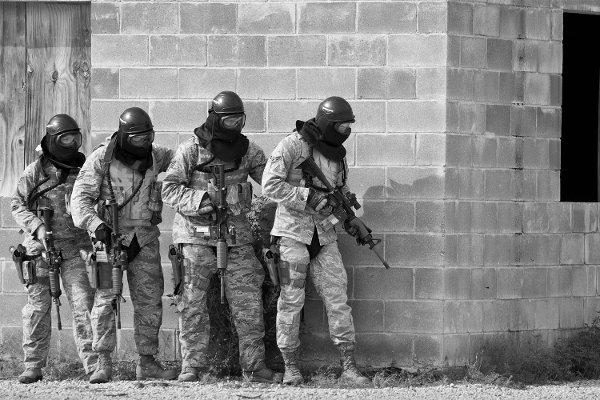Air Force May Soon Offer Service-Wide Mobile Alert System
Military.com, Feb 07, 2017, by Oriana Pawlyk

A team of 96th Security Forces Squadron Airmen prepare to enter a building during a shoot, move and communicate drill in June at Eglin Air Force Base, Fla. (U.S. Air Force photo/Samuel King Jr.)
The U.S. Air Force may soon roll out a service-wide mobile alert system to notify airmen and employees of active shooters or other emergencies on base, a general said.
The service is pushing to set up the technology this year, possibly even within the next few months, according to Lt. Gen. John Cooper, Air Force deputy chief of staff for logistics, engineering and force protection at the Pentagon.
"We challenged ourselves: can we get an amber alert-type [system] on cell phones?" Cooper said during a recent Air Force Association breakfast near Washington D.C. "Before the end of this year -- I think in the next three months, but I'll say before the end of the year -- the whole Air Force will be set up regionally."
The Air Force, as well as the other branches,
have stepped up the use of social media websites such as Facebook and Twitter to get the word out to base personnel and families on emergencies and quickly developing situations.
But the direct messaging systems will be created to alert airmen -- and any local command posts in the same region, Cooper said. For example, in the National Capital Region, or NCR -- the area in and around Washington, D.C. -- military bases have already established a unified system, he said.
"In the NCR, the Navy had a program, the Army had a program, Air Force had a program and the Marines had a program. [But] if something happened on Bolling Air Force Base, [in Maryland] I could be driving to the B-X from my house and all the sailors would be jumping in a ditch, and I'd be jumping right into the fire," Cooper said. "We got that all fixed, so any command post in the National Capital Region…pushes a button and every military gets notified immediately."
The general also said the system shouldn't be monopolized by a major command, citing Hill Air Force Base, Utah, a base with two different active-duty commands -- Air Force Material Command and Air Combat Command -- as well as an Air Force Reserve Command unit.
"They're [all] the same Air Force," he said. "One person should push a button and everyone should get notified."
The Air Force immediately began increasing its protection services at various bases, implementing lower-end, but critical enhancements such as preventative fences and bullet resistant film for glass in the wake of the deadly 2015 shootings in Chattanooga, Tennessee, which killed four Marines and a sailor at a recruiting station and reserve center, Cooper told Air Force Times in July.
In 2016, the service implemented three more programs -- Unit Marshal, Law Enforcement Officer Safety Act, and Security Forces Staff Arming -- that allowed more airmen to carry firearms in the workplace.
"We basically set up a concept so an airman can arm themselves with their personal weapon until they get to the office, the worksite -- and from there at the worksite, at the base, the government will make it more secure," Cooper said Friday.
The security forces program enables more security forces members -- who have the appropriate Air Force specialty code and who work in staff billets at the squadron, group, wing or major command -- to carry a government-issued weapon while on duty with the approval of the installation commander, according to a release.
Unit Marshal, the newest program, gives commanders permission, with the installation commander's approval, to work with security forces to train more airmen and allow them to open carry an M9 pistol in their duty location, the release said. UMP is meant to act as "a blocking force," Cooper said. "Somebody comes into an office that's going to do something stupid a blue could shoot back and basically block until the [remaining law enforcements] get there," Cooper said.
Lastly, with the Law Enforcement Officer Safety Act or LEOSA, "Congress gave us legislation ... which allowed credentialed defenders to carry concealed weapons on base, and the Air Force used it; we actually paid for our airmen to get the credential but we didn't enforce it, [but] we kicked that in after Chattanooga," Cooper said.
The legislation applies to present security forces members as well as separated or retired members as long as they meet appropriate criteria cleared by the service. The 2004 federal act was extended to apply to military personnel in 2013.
The Air Force's programs already go hand-in-hand with policies stated in a Nov. 18 Defense Department directive approved by Deputy Secretary of Defense Robert Work that allow Defense Department personnel to carry firearms and employ deadly force while performing official duties.
"When you say high-consequence, I think our airmen," Cooper said. "Chattanooga. We just say Chattanooga and everybody on my staff understands that."
-- Oriana Pawlyk can be reached at This email address is being protected from spambots. You need JavaScript enabled to view it.. Follow her on Twitter at @Oriana0214.
